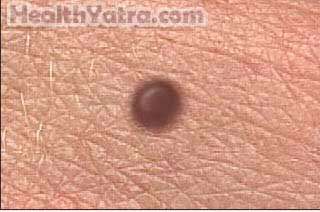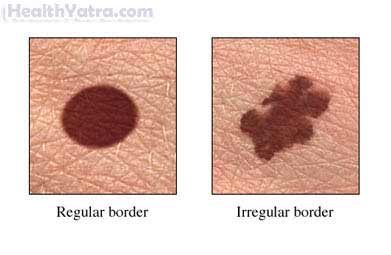परिभाषा
Moles are spots on the skin where pigmented cells have clustered together. They typically appear as light to dark brown spots on the skin that are either flat or raised. Most people have benign moles, which are harmless.
Moles that become atypical (called dysplastic nevi) might eventually becomemelanoma. Melanoma is a form of skin cancer. Moles that change or look atypical need to be evaluated by your doctor or a dermatologist.

का कारण बनता है
Moles develop from pigment-producing cells in the skin called melanocytes. Normally, these cells are evenly distributed in your skin. When you have a mole, it is because these cells form a cluster.
जोखिम कारक
These factors increase your chance of developing moles:
- Moles present at birth (This increases the likelihood of more moles later in life.)
- Family members with moles
- Excessive exposure to sunlight, especially sunburn
लक्षण
Most people have some benign moles that appear at birth, childhood, or adolescence. Most adults have 10-40 moles.
Benign moles, which can appear anywhere on the body, are usually:
- Dark brown, but can also be yellow-brown or flesh tone
- One color
- Round or oval with distinct edges
- Flat and smooth, but may occasionally become raised, rough, or grow hair
Signs that a mole may be atypical include:
- Sudden change in size, color, shape, texture, or sensation
- Large size (¼ inch or more across, about the size of an eraser at the end of a pencil)
- A mixture of colors, often including black
- Irregular edges
- Abnormal surface that is:
- स्केलिंग
- Flaking
- Oozing
- खून बह रहा है
- Open with a sore that will not heal
- Hard and raised lump
- Itchy, tender, or painful
- Abnormally colored skin around it

मुझे अपने डॉक्टर को कब बुलाना चाहिए?
If you are concerned about a mole because it looks different from the others, or you are over age 30 and notice a new mole, call your doctor. Also call your doctor if you notice any signs that an existing mole may be atypical.
निदान
The doctor will examine your skin and ask about your symptoms and medical history.
परीक्षण में शामिल हो सकते हैं:
- Biopsy—removal of all or part of the mole to be tested for cancer cells
उपचार
Benign moles do not need to be treated. However, surgery may be done to remove those that are unsightly or irritated.
Treatment for atypical moles include monitoring or removal. Atypical moles that are cancerous or suspected of being cancerous can be removed. The mole tissue is examined under a microscope. If cancer cells are found, more surgery is done to remove any remaining portion of the mole and surrounding tissue.
रोकथाम
To help prevent benign moles from becoming atypical (and possibly cancerous):
- धूप में ज्यादा समय बिताने से बचें।
- Protect your skin from the sun. For example, wear a shirt, wide brim hat, and sunglasses.
- Use sunscreen with a sun protection factor (SPF) of at least 15.
To detect atypical or cancerous moles early:
- Monitor your moles, especially atypical ones.
- Report any changes in a mole to your doctor.
- Have your doctor check and monitor atypical moles on a regular basis. Have moles checked more often if you have:
- A large number of moles
- A family or personal history of atypical moles or melanoma
Have moles removed if your doctor recommends it.
